SST Anomalies in the Mozambique Channel Using Remote Sensing and Numerical Modeling Data
Abstract
1. Introduction
2. Data, Model Configuration and Method
2.1. Satellite Data
2.1.1. Reynolds’ SST Data
2.1.2. TMI Cloud Data
2.1.3. AVISO Geostrophic Current Data
2.1.4. AVHRR SST Data
2.2. NCEP CFSR Reanalysis Data
2.3. Model Configuration
2.4. Eddy Automatic Detection.
3. Results
3.1. Phenomena: SST Anomalies in the MC
3.2. Mechanisms: SST Anomalies in the MC
3.2.1. Wind Field Variation
3.2.2. Heat Flux
3.2.3. Surface Mixed Layer Depth
4. Discussion
4.1. Mixed Layer Budgets of Temperature
4.2. Eddies inside the MC
5. Conclusions
Author Contributions
Funding
Acknowledgments
Conflicts of Interest
Appendix A
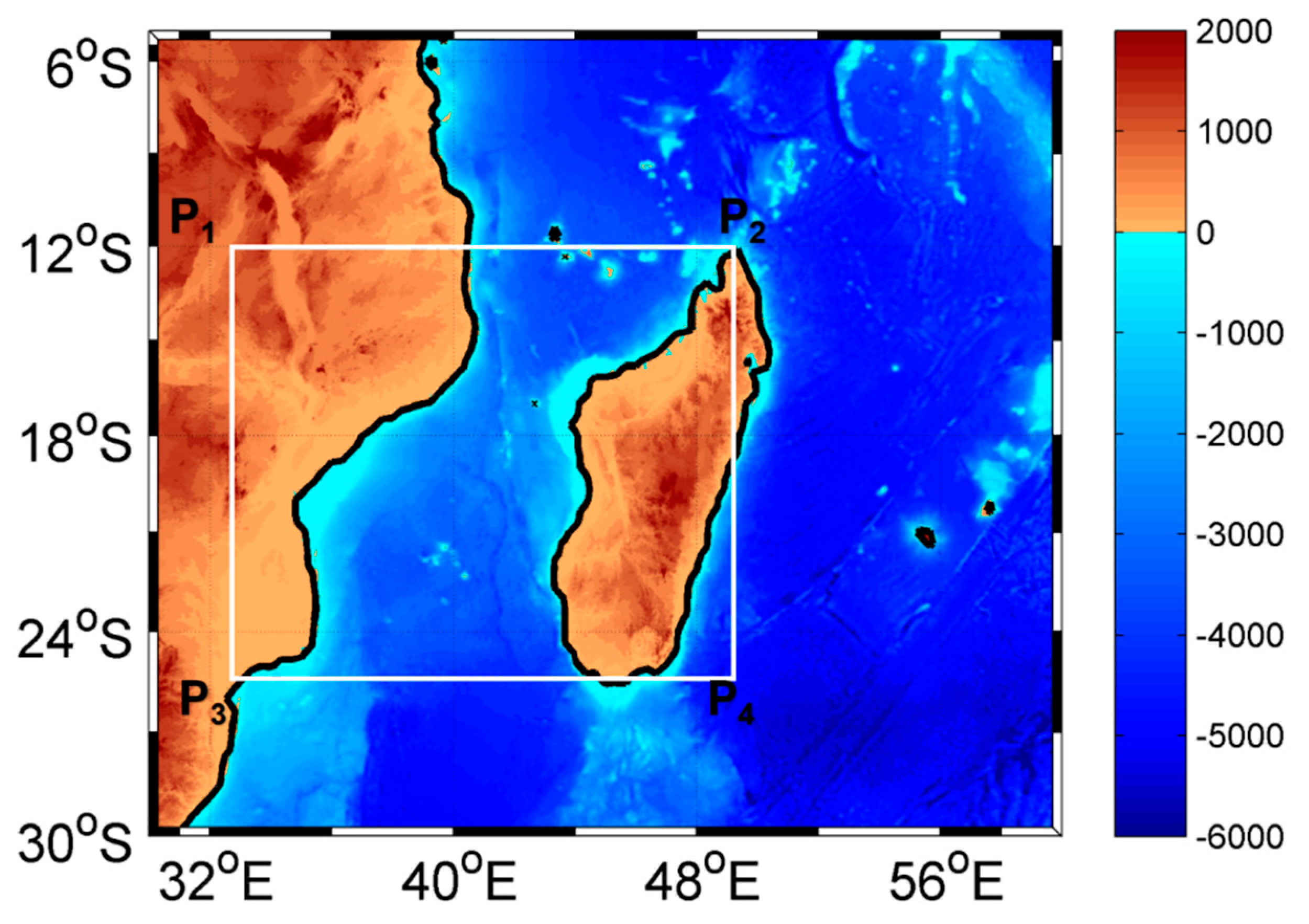

References
- Dietrich, D.E.; Bowman, M.J.; Lin, C.A.; Mestas-Nunez, A. Numerical studies of small island wakes in the ocean. Geophys. Astrophys. Fluid Dyn. 1996, 83, 195–231. [Google Scholar] [CrossRef]
- Aiken, C.M.; Moore, A.M.; Middleton, J.H. The non-normality of coastal ocean flows around obstacles, and their response to stochastic forcing. J. Phys. Oceanogr. 2002, 32, 2955–2974. [Google Scholar] [CrossRef]
- Coutis, P.F.; Middleton, J.H. The physical and biological impact of a small island wake in the deep ocean. Deep-Sea Res. 2002, 49, 1341–1361. [Google Scholar] [CrossRef]
- Barton, E.D.; Basterretxea, G.; Flament, P.; Gay Mitchelson-Jacob, E.; Jones, B.; Arístegui, J.; Herrera, F. Lee region of Gran Canaria. J. Geophys. Res.-Oceans 2000, 105, 17173–17193. [Google Scholar] [CrossRef]
- Andrade, I.; Sangrà, P.; Hormazabal, S.; Correa-Ramirez, M. Island mass effect in the Juan Fernández Archipelago (33°S), Southeastern Pacific. Deep Sea Res. Part I 2014, 84, 86–99. [Google Scholar] [CrossRef]
- Harlan, J.A.; Swearer, S.E.; Leben, R.R.; Fox, C.A. Surface circulation in a Caribbean island wake. Cont. Shelf Res. 2002, 22, 417–434. [Google Scholar] [CrossRef]
- Neill, S.P.; Elliott, A.J. Observations and simulations of an unsteady island wake in the Firth of Forth, Scotland. Ocean Dyn. 2004, 54, 324–332. [Google Scholar] [CrossRef]
- Dong, C.; Mcwilliams, J.C. A numerical study of island wakes in the Southern California Bight. Cont. Shelf Res. 2007, 27, 1233–1248. [Google Scholar] [CrossRef]
- Dong, C.; Mcwilliams, J.C.; Shchepetkin, A.F. Island wakes in deep water. J. Phys. Oceanogr. 2007, 37, 962–981. [Google Scholar] [CrossRef]
- Dong, C.; Cao, Y.; McWilliams, J.C. Island Wakes in Shallow Water. Atmos. Ocean. 2018. [Google Scholar] [CrossRef]
- Tomczak, M. Island wakes in deep water and shallow water. J. Geophys. Res. 1988, 93, 5153–5154. [Google Scholar] [CrossRef]
- Barton, E.D.; Flament, P.; Dodds, H.; Mitchelsonjacob, E.G. Mesoscale structures viewed by SAR and AVHRR near the Canary islands. Sci. Mar. 2001, 65, 167–175. [Google Scholar] [CrossRef]
- Xie, S.P.; Liu, W.T.; Liu, Q.; Nonaka, M.; Hafner, J. Far-Reaching Effects of the Hawaiian Islands on the Pacific Ocean-Atmosphere System. Science 2001, 292, 2057–2060. [Google Scholar] [CrossRef] [PubMed]
- Caldeira, R.M.; Marchesiello, P. Ocean response to wind sheltering in the Southern California Bight. Geophys. Res. Lett. 2002, 29, 13-1–13-4. [Google Scholar] [CrossRef]
- Caldeira, R.M.; Marchesiello, P.; Nezlin, N.; Digiacomo, P.; Mcwilliams, J.C. Island wakes in the Southern California Bight. J. Geophys. Res.-Oceans 2005, 110, 1233–1248. [Google Scholar] [CrossRef]
- Li, J.; Wang, G.; Xie, S.P.; Zhang, R.; Sun, Z. A winter warm pool southwest of Hainan Island due to the orographic wind wake. J. Geophys. Res.-Oceans 2012, 117, C08036. [Google Scholar] [CrossRef]
- Arivelo, T.A.; Lin, Y.L. Climatology of Heavy Orographic Rainfall Induced by Tropical Cyclones over Madagascar: From Synoptic to Mesoscale Perspectives. Earth Sci. Res. 2016, 5, 146–161. [Google Scholar] [CrossRef][Green Version]
- Reynolds, R.W.; Smith, T.M.; Liu, C.; Chelton, D.B.; Casey, K.S.; Schlax, M.G. Daily high-resolution blended analyses for sea surface temperature. J. Clim. 2007, 20, 5473–5496. [Google Scholar] [CrossRef]
- Wentz, F.J.; Gentemann, C.; Smith, D.; Chelton, D. Satellite measurements of sea surface temperature through clouds. Science 2000, 288, 847–850. [Google Scholar] [CrossRef] [PubMed]
- Ducet, N.; Traon, P.Y.; Reverdin, G. Global high-resolution mapping of ocean circulation from TOPEX/Poseidon and ERS-1 and-2. J. Geophys. Res. 2000, 105, 19477–19498. [Google Scholar] [CrossRef]
- Saha, S.; Moorthi, S.; Pan, H.-L.; Wu, X.; Wang, J.; Nadiga, S.; Liu, H. The NCEP Climate Forecast System Reanalysis. Bull. Am. Meteorol. Soc. 2010, 91, 1015–1057. [Google Scholar] [CrossRef]
- Saha, S.; Moorthi, S.; Wu, X.; Wang, J.; Nadiga, S.; Tripp, P.; Ek, M. The NCEP Climate Forecast System Version 2. J. Clim. 2014, 27, 2185–2208. [Google Scholar] [CrossRef]
- Shchepetkin, A.F.; McWilliams, J.C. The regional oceanic modeling system (ROMS): A split-explicit, free-surface, topography-following-coordinate oceanic model. Ocean Model. 2005, 9, 347–404. [Google Scholar] [CrossRef]
- Li, J.; Liang, C.; Tang, Y.; Dong, C.; Chen, D.; Liu, X.; Jin, X. A new dipole index of the salinity anomalies of the tropical Indian Ocean. Sci. Rep. 2016, 6, 24260. [Google Scholar] [CrossRef] [PubMed]
- Li, J.; Liang, C.; Tang, Y.; Liu, X.; Lian, T.; Shen, Z.; Li, X. Impacts of the iod-associated temperature and salinity anomalies on the intermittent equatorial undercurrent anomalies. Clim. Dyn. 2018, 51, 1391–1409. [Google Scholar] [CrossRef]
- Nencioli, F.; Changming, D.; Dickey, T.; Washburn, L.; McWilliams, J.C. A Vector Geometry–Based Eddy Detection Algorithm and Its Application to a High-Resolution Numerical Model Product and High-Frequency Radar Surface Velocities in the Southern California Bight. J. Atmos. Ocean. Technol. 2010, 27, 564. [Google Scholar] [CrossRef]
- DiMego, G.J.; Bosart, L.F. The Transformation of Tropical Storm Agnes into an Extratropical Cyclone. Part I: The Observed Fields and Vertical Motion Computations. Mon. Weather Rev. 1982, 110, 385. [Google Scholar] [CrossRef]
- Zhang, Y.; Xu, H.; Qiao, F.; Dong, C. Seasonal variation of the global mixed layer depth: Comparison between Argo data and FIO-ESM. Front. Earth Sci. 2018, 12, 24–36. [Google Scholar] [CrossRef]
- Schiller, A.; Oke, P.R. Dynamics of ocean surface mixed layer variability in the Indian Ocean. J. Geophys. Res.-Oceans 2015, 120, 4162–4186. [Google Scholar] [CrossRef]
- Schiller, A.; Ridgway, K.R. Seasonal mixed layer dynamics in an eddy-resolving ocean Circulation Model. J. Geophys. Res.-Oceans 2013, 118, 3387–3405. [Google Scholar] [CrossRef]
- Schott, F.; Mccreary, J.P. The monsoon circulation of the Indian Ocean. Prog. Oceanogr. 2001, 51, 1–123. [Google Scholar] [CrossRef]
- Schott, F.A.; Xie, S.P.; Mccreary, J.P. Indian Ocean circulation and climate variability. Rev. Geophys. 2009, 47. [Google Scholar] [CrossRef]
- Ruijter, W.P.; Ridderinkhof, H.; Lutjeharms, J.R.; Schouten, M.W.; Veth, C. Observations of the flow in the Mozambique Channel. Geophys. Res. Lett. 2002, 29, 140-1–140-3. [Google Scholar] [CrossRef]
- Ullgren, J.E.; Aken, H.M.V.; Ridderinkhof, H.; Ruijter, W.P. The hydrography of the Mozambique Channel from six years of continuous temperature, salinity, and velocity observations. Deep Sea Res. Part I 2012, 69, 36–50. [Google Scholar] [CrossRef]
- Sun, W.; Dong, C.; Wang, R.; Liu, Y.; Yu, K. Vertical structure anomalies of oceanic eddies in the Kuroshio Extension region. J. Geophys. Res.-Oceans 2017, 122, 1476–1496. [Google Scholar] [CrossRef]
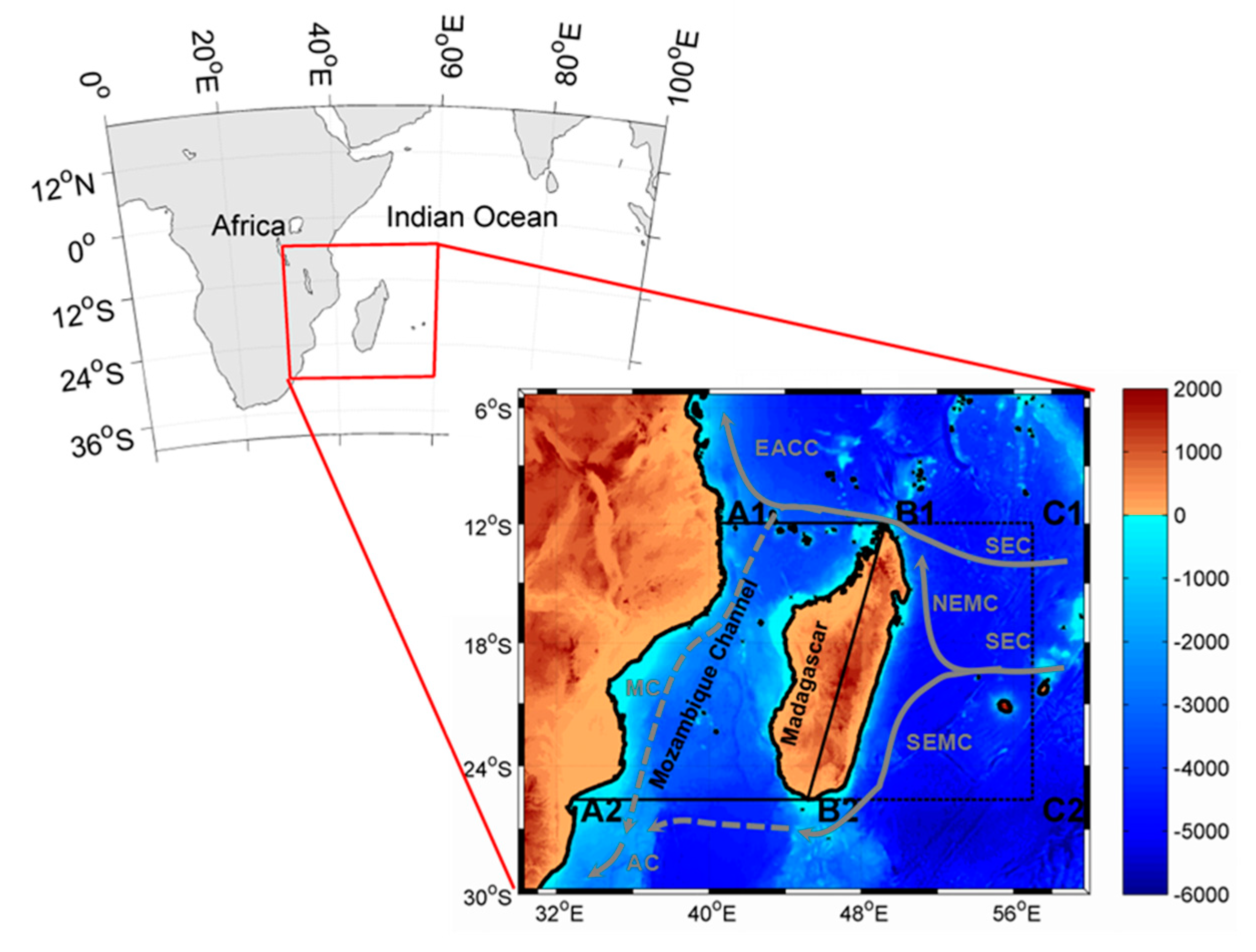
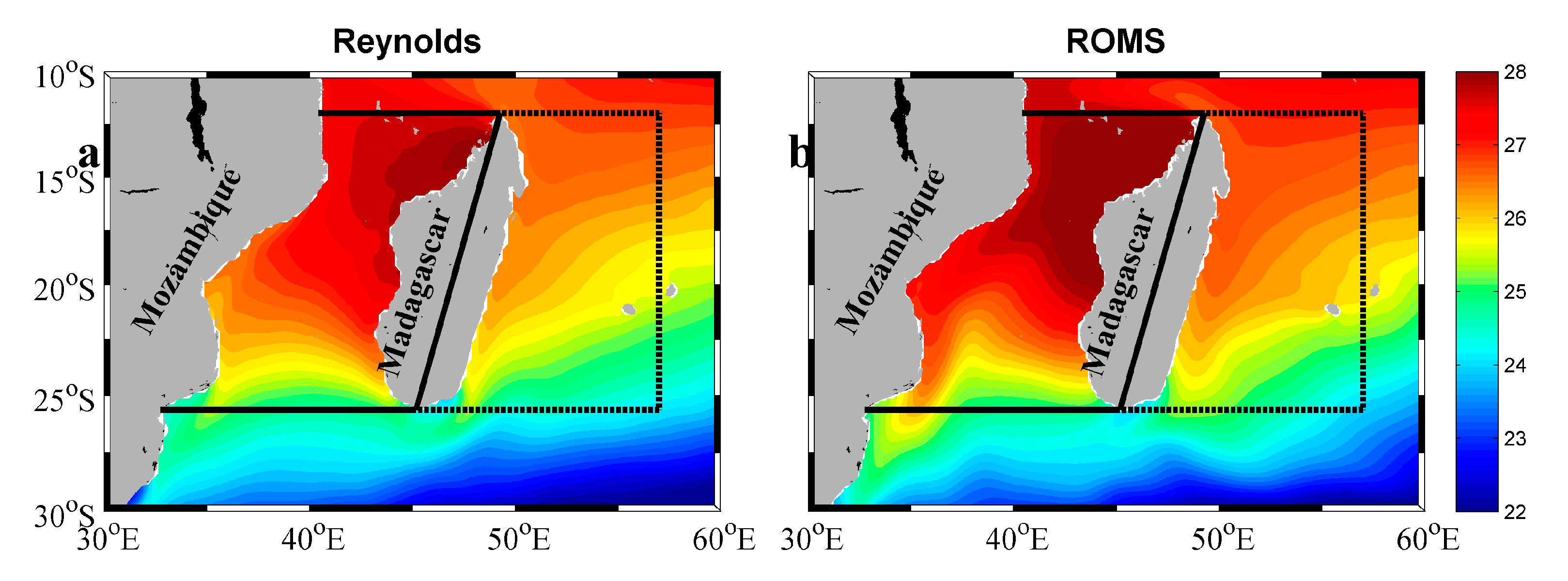
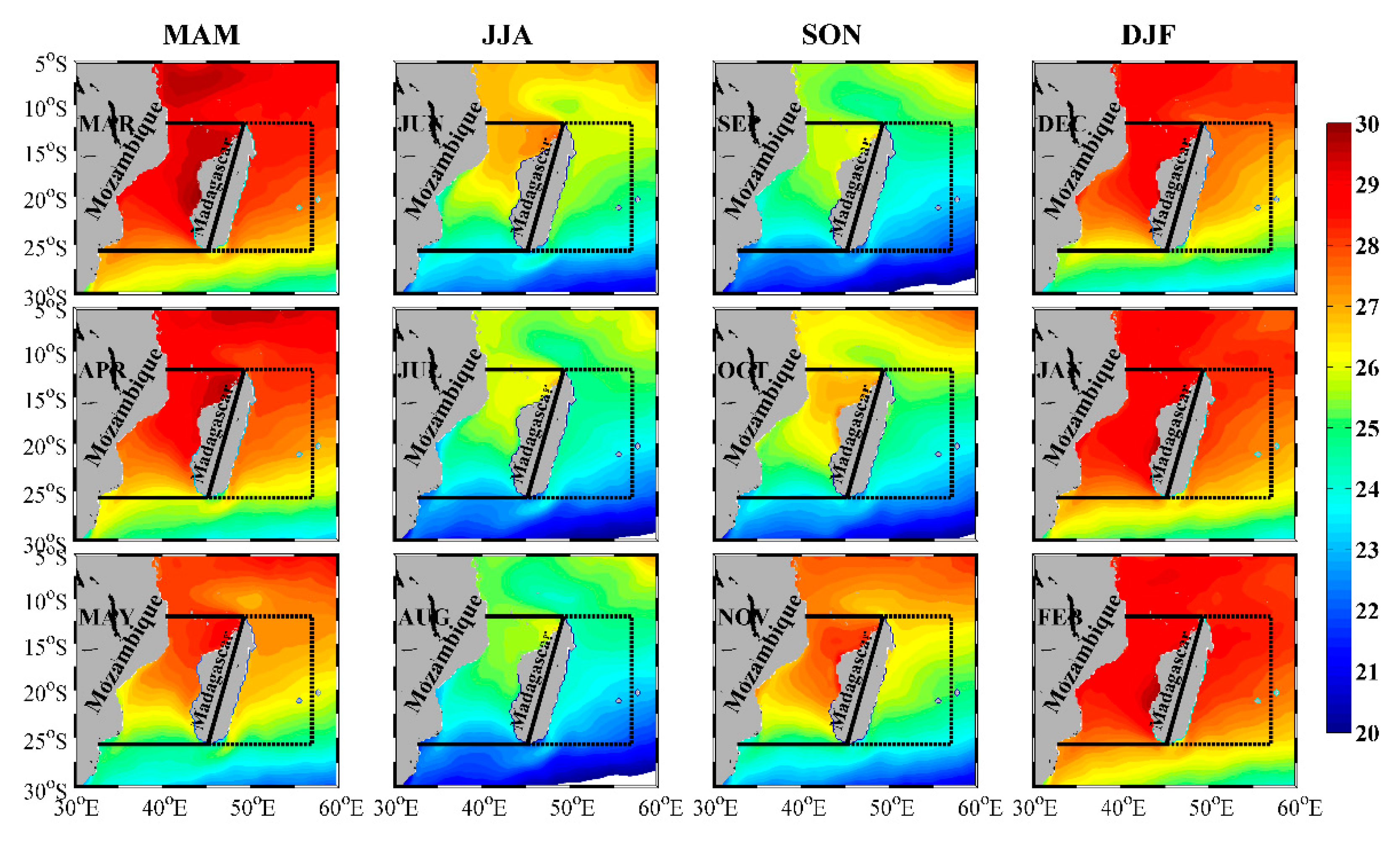
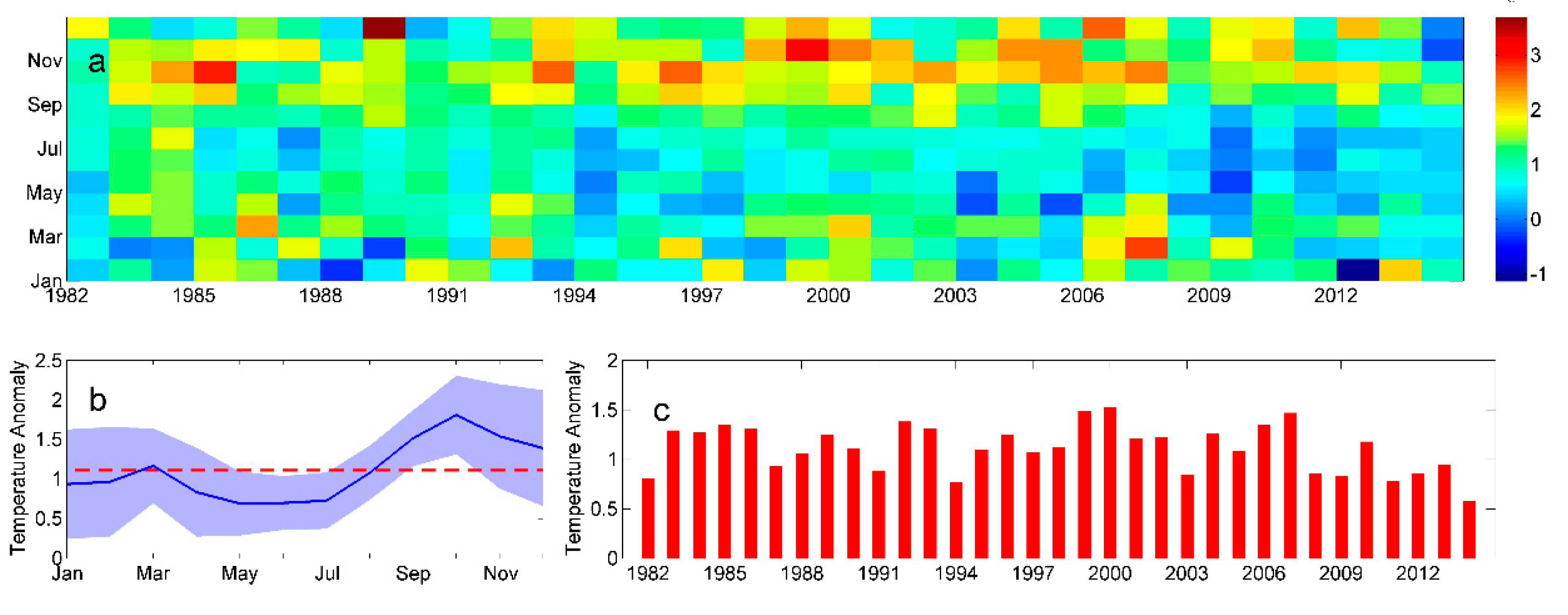
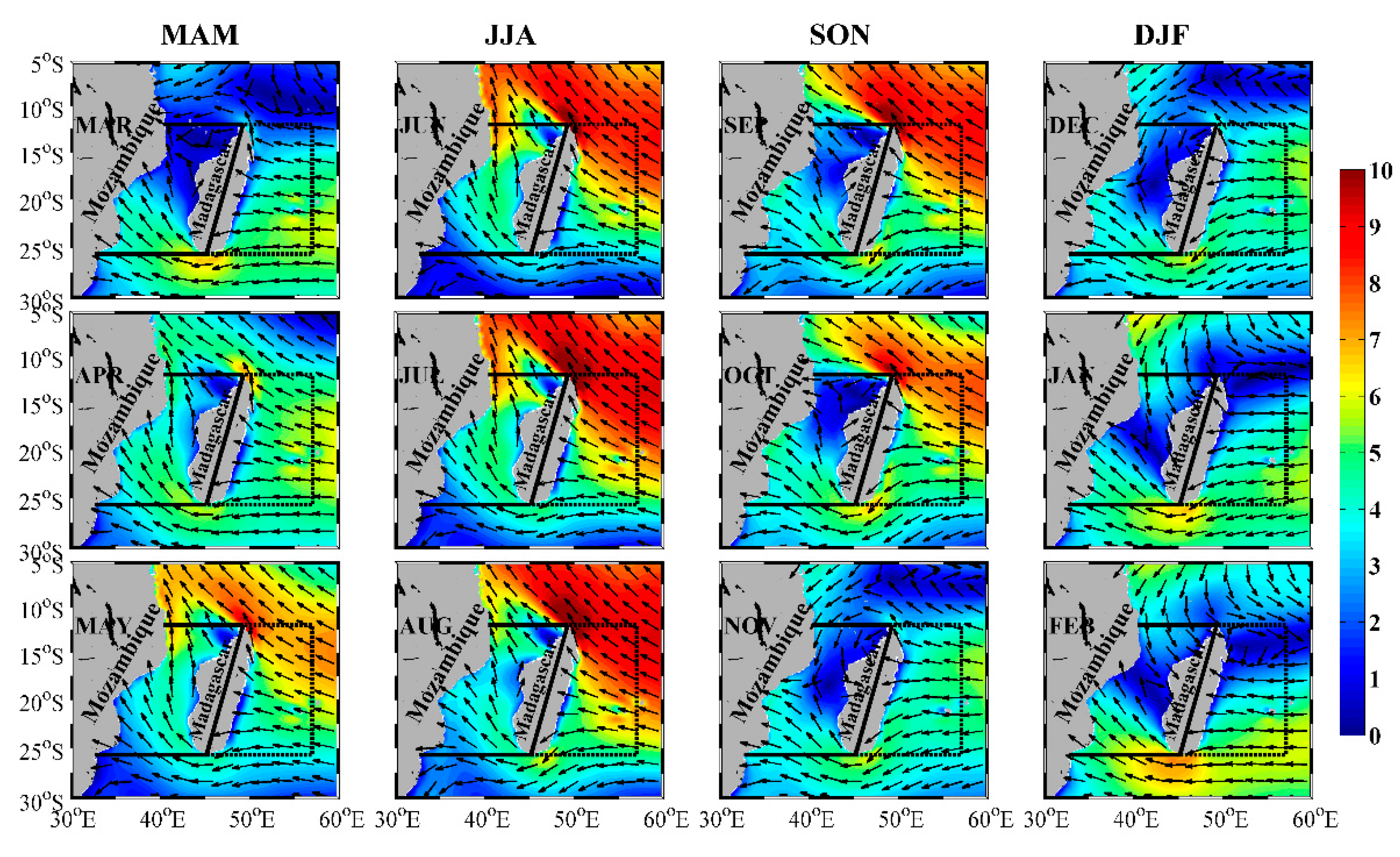

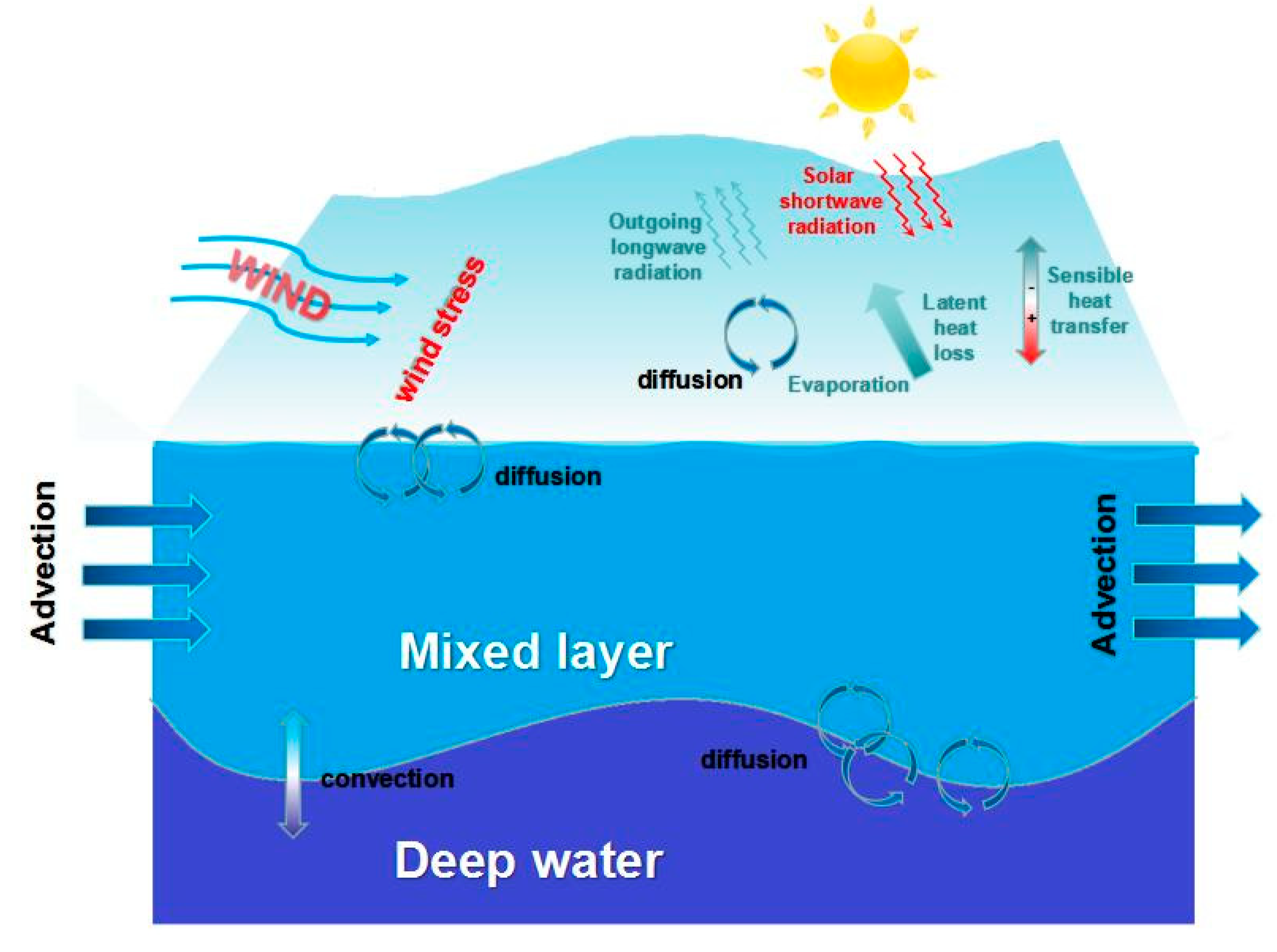
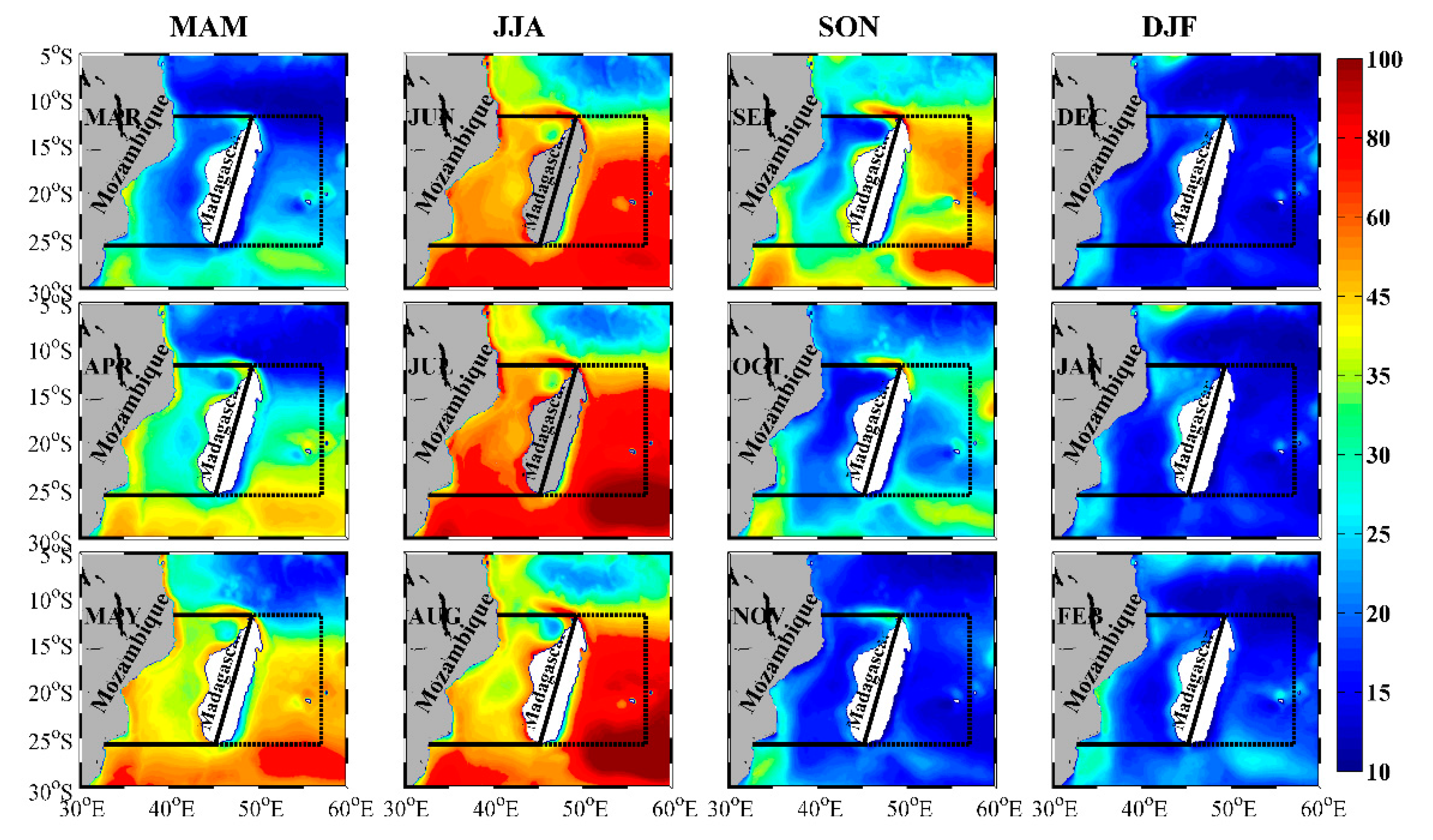

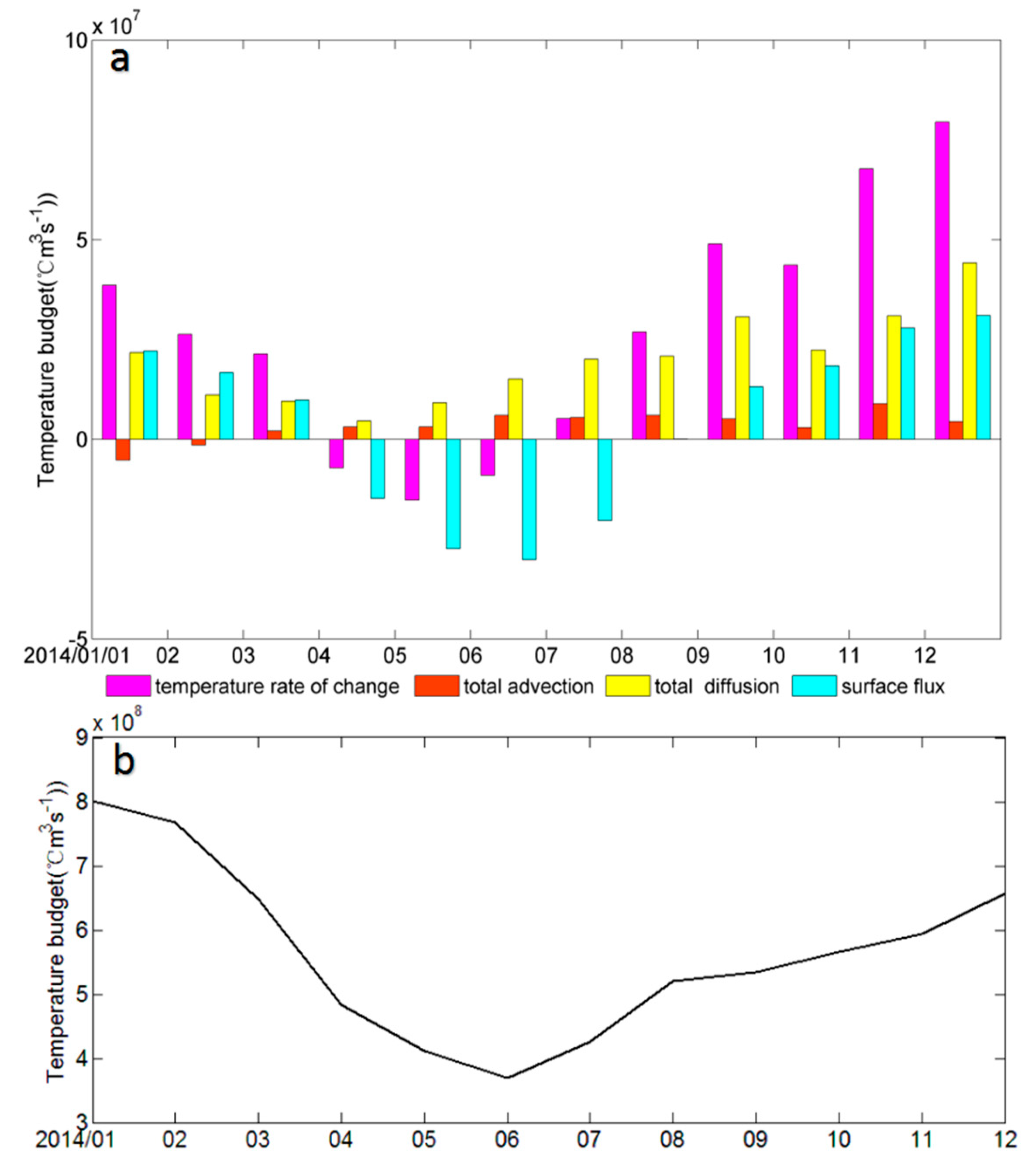

| Inside the MC | East of the MI | ||||
|---|---|---|---|---|---|
| A1 | 40°25′E | 11°57′S | B1 | 49°16′E | 11°57′S |
| B1 | 49°16′E | 11°57′S | C1 | 57°E | 11°57′S |
| A2 | 32°45′E | 25°37′S | B2 | 45°10′E | 25°37′S |
| B2 | 45°10′E | 25°37′S | C2 | 57°E | 25°37′S |
© 2019 by the authors. Licensee MDPI, Basel, Switzerland. This article is an open access article distributed under the terms and conditions of the Creative Commons Attribution (CC BY) license (http://creativecommons.org/licenses/by/4.0/).
Share and Cite
Han, G.; Dong, C.; Li, J.; Yang, J.; Wang, Q.; Liu, Y.; Sommeria, J. SST Anomalies in the Mozambique Channel Using Remote Sensing and Numerical Modeling Data. Remote Sens. 2019, 11, 1112. https://doi.org/10.3390/rs11091112
Han G, Dong C, Li J, Yang J, Wang Q, Liu Y, Sommeria J. SST Anomalies in the Mozambique Channel Using Remote Sensing and Numerical Modeling Data. Remote Sensing. 2019; 11(9):1112. https://doi.org/10.3390/rs11091112
Chicago/Turabian StyleHan, Guoqing, Changming Dong, Junde Li, Jingsong Yang, Qingyue Wang, Yu Liu, and Joel Sommeria. 2019. "SST Anomalies in the Mozambique Channel Using Remote Sensing and Numerical Modeling Data" Remote Sensing 11, no. 9: 1112. https://doi.org/10.3390/rs11091112
APA StyleHan, G., Dong, C., Li, J., Yang, J., Wang, Q., Liu, Y., & Sommeria, J. (2019). SST Anomalies in the Mozambique Channel Using Remote Sensing and Numerical Modeling Data. Remote Sensing, 11(9), 1112. https://doi.org/10.3390/rs11091112







